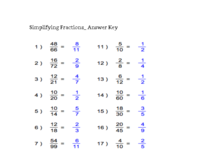Cutting Down to Size
How do you cut wood down to size?

OBJECTIVE: To learn how to simplify fractions
In previous lessons, you've worked mostly with INTEGERS.
Summing It Up: https://www.geogebra.org/m/ryw5cfbm
Switching Directions: https://www.geogebra.org/m/dkuqcztg
Getting Along: https://www.geogebra.org/m/fcebgdr7
In this lesson, you'll learn more about nonintegers, particularly FRACTIONS.
First, let's review vocabulary pertaining to FRACTIONS and closely related concepts.
FRACTION—part of a whole, any number of equal parts
NUMERATOR—top number of a fraction, the number of parts taken from the whole
DENOMINATOR—bottom number of a fraction, the number of parts into which a whole is divided
DIVISION BAR, also known as FRACTION BAR—the line that separates the numerator and denominator
UNIT FRACTION—a fraction where one part is taken from the whole, e.g.,  PROPER FRACTION—a fraction whose numerator is smaller than the denominator, e.g.,
PROPER FRACTION—a fraction whose numerator is smaller than the denominator, e.g.,  IMPROPER FRACTION—a fraction whose numerator is larger than the denominator, e.g.
IMPROPER FRACTION—a fraction whose numerator is larger than the denominator, e.g.  MIXED FRACTION, also known as MIXED NUMBER—a combination of a WHOLE NUMBER and a PROPER FRACTION, e.g.,
MIXED FRACTION, also known as MIXED NUMBER—a combination of a WHOLE NUMBER and a PROPER FRACTION, e.g.,  DECIMAL—a fraction whose denominator is a power of ten and whose numerator consists of the digits following the DECIMAL POINT (dot or period), e.g., 0.4 (equivalent to
DECIMAL—a fraction whose denominator is a power of ten and whose numerator consists of the digits following the DECIMAL POINT (dot or period), e.g., 0.4 (equivalent to  )
PERCENT—a decimal number multiplied by 100 and suffixed with the percent sign (%), e.g., 40%
EQUIVALENT FRACTIONS—two or more fractions whose numerators and denominators are different, but give the same value when simplified
LOWEST TERMS—the simplified form of a fraction
)
PERCENT—a decimal number multiplied by 100 and suffixed with the percent sign (%), e.g., 40%
EQUIVALENT FRACTIONS—two or more fractions whose numerators and denominators are different, but give the same value when simplified
LOWEST TERMS—the simplified form of a fraction
Here are different ways of representing a fraction:
SIMPLIFYING FRACTIONS
The process of simplifying fractions consists in dividing both numerator and denominator of the fractions by the GREATEST COMMON FACTOR or GCF.
Examples:



Below is a set of problems on simplifying fractions.
Simplifying Fractions
ANSWER BOX:
Check your answers below.
Simplifying Fractions_Answer Key
In this lesson, you learned how to simplify fractions or reduce them to lowest terms.
In future lessons, you'll learn more about fractions and fractional parts. Hope you had FUN today.

